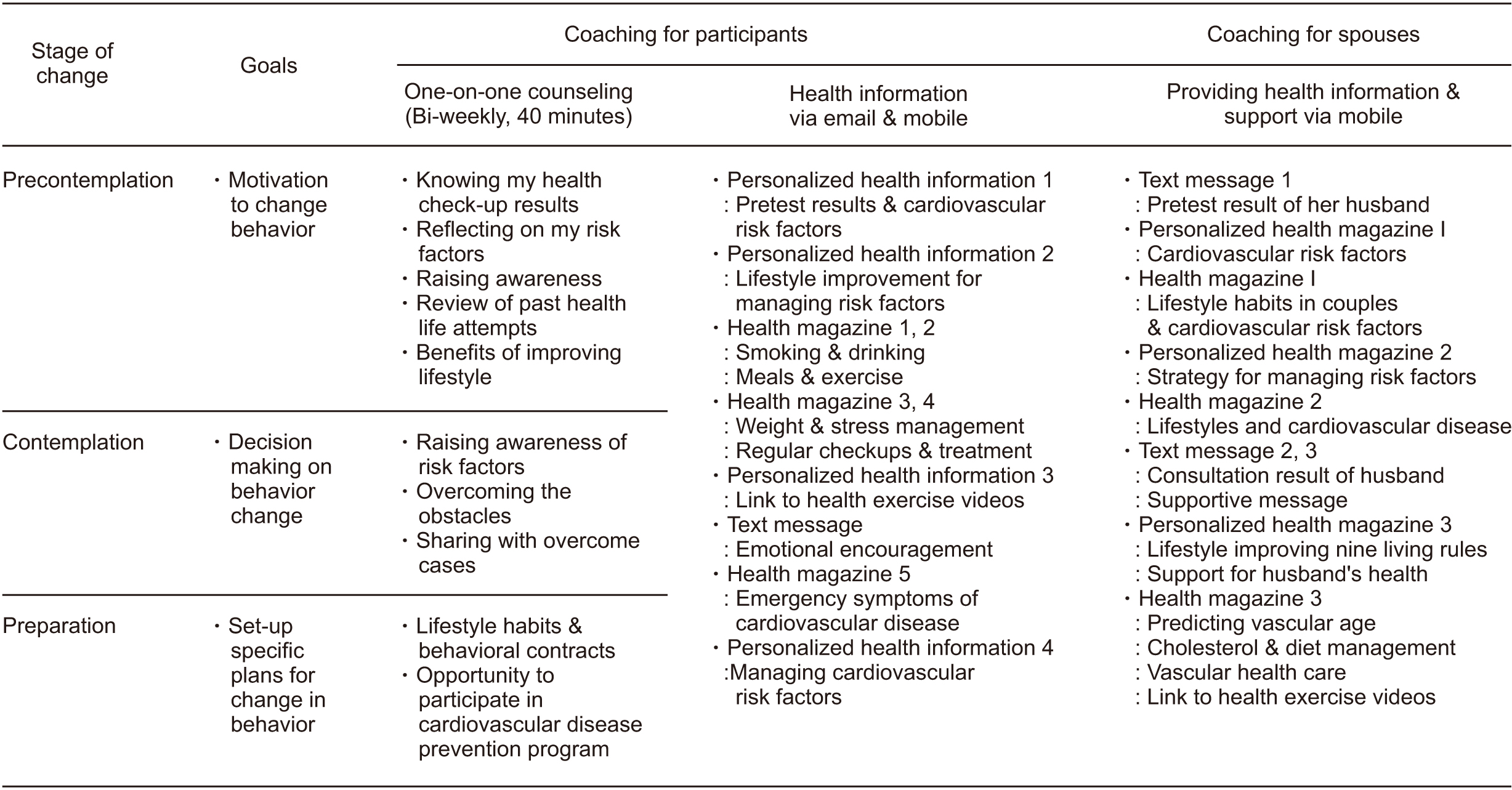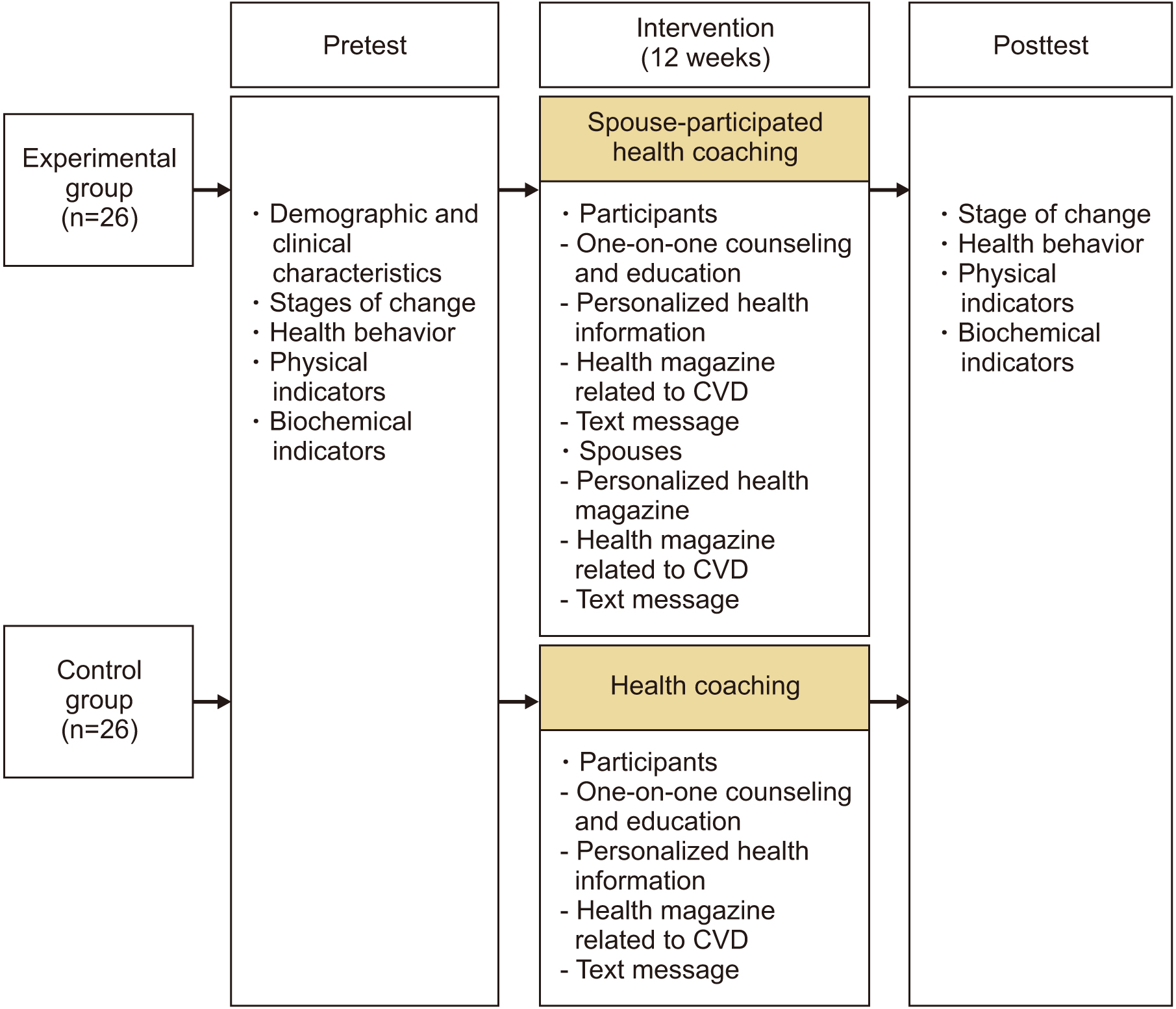J Korean Acad Nurs.
2019 Dec;49(6):748-759. 10.4040/jkan.2019.49.6.748.
Effects of Spouse-Participated Health Coaching for Male Office Workers with Cardiocerebrovascular Risk Factors
- Affiliations
-
- 1Department of Nursing, Koje College, Geoje, Korea
- 2School of Nursing, Hanyang University, Seoul, Korea
- KMID: 2505803
- DOI: http://doi.org/10.4040/jkan.2019.49.6.748
Abstract
- Purpose
This study aimed to examine the effect of spouses participating in health coaching on stage of the change, health behaviors, and physiological indicators among male office workers with cardiocerebrovascular disease (CVD) risk factors and compare the findings with trainers who provided health coaching only to workers.
Methods
A quasi-experimental pretest-posttest design was used. Convenience sampling was used to recruit participants from a manufacturing research and development company in the city of Gyeonggi province. The health coaching program for the experimental group (n=26) included individual counseling sessions according to workers’ stage of change, and provision of customized health information materials on CVD prevention to workers and their spouses for 12 weeks through mobile phone and email.
Results
After 12 weeks of intervention, the total score for health behavior, and scores on the sub-areas of exercise and health checkups significantly improved in the experimental group, but there were no significant differences in the scores of stage of the change and physical indicators. The results of a paired t-test showed a significant decrease in the body mass index, abdominal circumference, systolic blood pressure, diastolic blood pressure, total cholesterol and triglyceride values, and a significant increase in the high-density lipoprotein cholesterol value in the experimental group after the intervention.
Conclusion
To improve the health of male workers with CVD risk factors in the workplace, sharing health information with their spouses has proven to be more effective than health coaching for only workers. Therefore, it is important to develop strategies to encourage spousal participation when planning workplace health education for changing health-related behaviors.
Figure
Reference
-
1. Statistics Korea. Annual report on the causes of death statistics 2017 [Internet]. Daejeon: Statistics Korea;c2018. cited 2019 Feb 26. Available from: http://kostat.go.kr/assist/synap/preview/skin/doc.html?fn=synapview370710_1&rs=/assist/synap/preview.2. Korea Occupational Safety and Health Agency. Industrial accident analysis 2017 [Internet]. Sejong: Ministry of Employment and Labor;c2018. cited 2019 Feb 26. Available from: http://www.kosha.or.kr/kosha/data/industrialAccidentStatus.do?mode=view&articleNo=347616&article.offset=0&articleLimit=10.3. Korea Centers for Disease Control & Prevention. Korea health statistics 2017: Korea national health and nutrition examination survey (KNHANES VII-2) [Internet]. Sejong: Ministry of Health and Welfare;c2018. cited 2019 Jan 11. Available from: https://knhanes.cdc.go.kr/knhanes/sub04/sub04_03.do?classType=7.4. Artinian NT, Fletcher GF, Mozaffarian D, Kris-Etherton P, Van Horn L, Lichtenstein AH, et al. Interventions to promote physical activity and dietary lifestyle changes for cardiovascular risk factor reduction in adults: A scientific statement from the American Heart Association. Circulation. 2010; 122(4):406–441. DOI: 10.1161/CIR.0b013e3181e8edf1.5. Korea Centers for Disease Control & Prevention. Korea health statistics 2014: Korea national health and nutrition examination survey (KNHANES VI-2) [Internet]. Sejong: Ministry of Health and Welfare;c2015. cited 2018 Feb 18. Available from: https://knhanes.cdc.go.kr/knhanes/sub04/sub04_03.do?classType=7.6. Nam JY, Kim J, Cho KH, Choi Y, Choi J, Shin J, et al. Associations of sitting time and occupation with metabolic syndrome in South Korean adults: A cross-sectional study. BMC Public Health. 2016; 16(1):943. DOI: 10.1186/s12889-016-3617-5.7. Ministry of Employment and Labor. Categorized data of office and non-office workers [Internet]. Seoul: Ministry of Employment and Labor;c2018. cited 2018 Dec 22. Available from: http://www.moel.go.kr/local/seoul/info/dataroom/view.do?bbs_seq=20180900279.8. Kim GR, Park HR, Lee YM, Lim YS, Song KH. Comparative study on prevalence and components of metabolic syndrome and nutritional status by occupation and gender: Based on the 2013 Korea national health and nutrition examination survey. Journal of Nutrition and Health. 2017; 50(1):74–84. DOI: 10.4163/jnh.2017.50.1.74.9. Choi SY, Bin JE, Kim SH. An investigation of health status in male workers. The Korean Journal of Food And Nutrition. 2012; 25(4):1047–1054. DOI: 10.9799/ksfan.2012.25.4.1047.10. Hwang HJ, Lee EN. Effects of spousal support and self-efficacy on adherent behavior among patients with percutaneous coronary intervention. Journal of Korean Critical Care Nursing. 2012; 5(1):34–43.11. Park HJ, Kim YS, Lee JA, Sun WS. A study on the spousal concordance for cardiovascular risk factors. Paper presented at: Korean Society for Health Promotion and Disease Prevention 2015 Fall Conference. 2015 Nov 15; Seoul, Korea.12. Kim HC, Kang DR, Choi KS, Nam CM, Thomas GN, Suh I. Spousal concordance of metabolic syndrome in 3141 Korean couples: A nationwide survey. Annals of Epidemiology. 2006; 16(4):292–298. DOI: 10.1016/j.annepidem.2005.07.052.13. Hippisley-Cox J, Coupland C, Pringle M, Crown N, Hammersley V. Married couples' risk of same disease: Cross sectional study. BMJ. 2002; 325(7365):636. DOI: 10.1136/bmj.325.7365.636.14. Boyle RG, O'Connor PJ, Pronk NP, Tan A. Stages of change for physical activity, diet, and smoking among HMO members with chronic conditions. American Journal of Health Promotion. 1998; 12(3):170–175. DOI: 10.4278/0890-1171-12.3.170.15. Prochaska JO, Velicer WF. The transtheoretical model of health behavior change. American Journal of Health Promotion. 1997; 12(1):38–48. DOI: 10.4278/0890-1171-12.1.38.16. Jung HS, Jang WG. An intervention study for hypertension in small scale enterprises based on transtheoretical and ecological model. Korean Journal of Occupational Health Nursing. 2006; 15(2):153–164.17. Kim EY, Hwang SY. Development and evaluation of a small group-based cardiocerebrovascular disease prevention education program for male bus drivers. Journal of Korean Academy of Nursing. 2012; 42(3):322–332. DOI: 10.4040/jkan.2012.42.3.322.18. Kim EJ. Psychology of coaching an approach topsychology-based coaching. Seoul: Hakjisa;2016. p. 232.19. Bennett HD, Coleman EA, Parry C, Bodenheimer T, Chen EH. Health coaching for patients with chronic illness. Family Practice Management. 2010; 17(5):24–29.20. Jo HS, Jung SM, Lee HJ. The evaluation of a health coaching program on metabolic syndrome patients. Korean Journal of Health Education and Promotion. 2012; 29(1):97–108.21. Lee SY, Park HS, Kim DJ, Han JH, Kim SM, Cho GJ, et al. Appropriate waist circumference cutoff points for central obesity in Korean adults. Diabetes Research and Clinical Practice. 2007; 75(1):72–80. DOI: 10.1016/j.diabres.2006.04.013.22. Expert Panel, Evaluation , and Treatment. Executive summary of the third report of the national cholesterol education program (NCEP) expert panel on detection, evaluation, and treatment of high blood cholesterol in adults (Adult Treatment Panel III). JAMA. 2001; 285(19):2486–2497. DOI: 10.1001/jama.285.19.2486.23. DiClemente CC, Carbonari JP, Montgomery RP, Hughes SO. The alcohol abstinence self-efficacy scale. Journal of Studies on Alcohol. 1994; 55(2):141–148. DOI: 10.15288/jsa.1994.55.141.24. Kang KJ, Song MS. Development and evaluation of motivational enhancement therapy for patients with coronary artery disease. Journal of Korean Clinical Nursing Research. 2010; 16(2):5–16.25. University of Maryland, Baltimore County (UMBC). The HABITS Lab at UMBC. Readiness score for URICA [Internet]. Baltimore (MD): UMBC;c2004. cited 2017 Jun 23. Available from: https://habitslab.umbc.edu/urica-readiness-score/.26. Park HJ. The effects of lifestyle modification education program on the workers' knowledge, attitude and behavior to prevent cerebrocardiovascular diseases in middle and small-sized industries [master's thesis]. Seoul: Dongguk University;2008. 1–110.27. Prochaska JO, DiClemente CC. Stages and processes of self-change of smoking: Toward an integrative model of change. Journal of Consulting and Clinical Psychology. 1983; 51(3):390–395. DOI: 10.1037//0022-006X.51.3.390.28. Moore M, Highstein G. Principles of behavioral psychology in wellness coaching. In : In : Stein IF, Campone F, Page LJ, editors. Proceedings of the second ICF Coaching Research Symposium. Proceedings of the 2nd International Coach Federation's Coaching Research Symposium; 2004 Nov 3; Québec, Canada. Washington, D.C.: International Coach Federation;2005. p. 12.29. Burke LE, Dunbar-Jacob J, Orchard TJ, Sereika SM. Improving adherence to a cholesterol-lowering diet: A behavioral intervention study. Patient Education and Counseling. 2005; 57(1):134–142. DOI: 10.1016/j.pec.2004.05.007.30. Lee YW, Kim HS, Cho EY. The influencing factors on health behavior of patients with coronary artery disease. Journal of Korean Academy of Nursing. 2002; 32(1):40–49. DOI: 10.4040/jkan.2002.32.1.40.31. Franks MM, Stephens MAP, Rook KS, Franklin BA, Keteyian SJ, Artinian NT. Spouses' provision of health-related support and control to patients participating in cardiac rehabilitation. Journal of Family Psychology. 2006; 20(2):311–318. DOI: 10.1037/0893-3200.20.2.311.32. Rowland SA, Schumacher KL, Leinen DD, Phillips BG, Schulz PS, Yates BC. Couples' experiences with healthy lifestyle behaviors after cardiac rehabilitation. Journal of Cardiopulmonary Rehabilitation and Prevention. 2018; 38(3):170–174. DOI: 10.1097/HCR.0000000000000259.33. Kivelä K, Elo S, Kyngäs H, Kääriäinen M. The effects of health coaching on adult patients with chronic diseases: A systematic review. Patient Education and Counseling. 2014; 97(2):147–157. DOI: 10.1016/j.pec.2014.07.026.
- Full Text Links
- Actions
-
Cited
- CITED
-
- Close
- Share
- Similar articles
-
- Factors Affecting the Preventive Behavior of Cardiocerebrovascular Disease in Blue Color Workers
- Occupational Diseases among Office Workers
- Development and Usability Evaluation of a Healthy Lifestyle Coaching Chatbot Using a Habit Formation Model
- A Longitudinal Investigation of the Moderating Effect of Social Support on Job Strain Developing Non-Specific Neck Pain in Office Workers
- Factors Influencing Health Promoting Behaviour according to the Type A/B Personality of White Collar Workers



